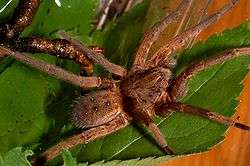Ancylometes
| Ancylometes | |
|---|---|
 | |
| Ancylometes bogotensis | |
| Scientific classification | |
| Kingdom: | Animalia |
| Phylum: | Arthropoda |
| Class: | Arachnida |
| Order: | Araneae |
| Suborder: | Araneomorphae |
| Family: | Ctenidae |
| Genus: | Ancylometes Bertkau, 1880 |
| Species | |
|
See text. | |
| Diversity | |
| 11 species | |
Ancylometes is a fishing spider genus from Central and South America, where they live near ponds, lakes, rivers and other freshwater habitats. These spiders can walk over water rather fast, in a fashion similar to water striders. This is because of fine air-trapping hairs on the tips of their legs. They can dive underwater, and will consume anything from insects to small lizards and fish. They can stay underwater for over an hour, using air trapped in hairs surrounding their book lungs as a physical gill. Ancylometes is one of only two known genera of spiders that can spin webs in water (the other being Argyroneta) and they do sometimes catch fish. However, they mostly catch fish by diving down or lying in wait until prey passes within striking distance. They do however consume them on the ground or above the water.
With a typical body length of 1.5 to 4 cm (0.59 to 1.57 in), Ancylometes are among the largest araneomorph spiders (tarantulas and allies are mygalomorphs) and they are sometimes called giant fishing spiders to separate them from the smaller Dolomedes fishing spiders. The largest Ancylometes is A. rufus where females have a body length of up to 5 cm (2.0 in) and a leg span up to 12 cm (4.7 in), while males grow up to 3 cm (1.2 in) in body length, but with longer legs than the female. Both sexes are brown with dark spots on the abdomen, with two thin lines along the carapace of the male.
The male immobilizes the female with silk during mating, while the female enters an immobile state by itself. The female produces a cocoon after about a week, which is carried with the fangs. After a month, the female builds a nursery web above the ground which is about 10 cm in diameter. More than 100 spiderlings (each about 2 mm long) hatch inside the egg case. A spiderling takes about a year to mature. Males die after at the most 16 months, while females can live for more than two years.
Until 1967, the genus was considered to belong to the family Pisauridae, but was then moved to the family Ctenidae.
The genus name is derived in part from Greek ancylo-, meaning "crooked, bent".
Species
- Ancylometes amazonicus Simon, 1898 (Peru, Brazil)
- Ancylometes birabeni (Carcavallo & Martínez, 1961) (Argentina)
- Ancylometes bogotensis (Keyserling, 1877) (Honduras to Bolivia)
- Ancylometes concolor (Perty, 1833) (Brazil, Bolivia, Paraguay, Argentina)
- Ancylometes hewitsoni (F. O. P.-Cambridge, 1897) (Bolivia, Brazil)
- Ancylometes japura Höfer & Brescovit, 2000 (Brazil)
- Ancylometes jau Höfer & Brescovit, 2000 (Brazil)
- Ancylometes pantanal Höfer & Brescovit, 2000 (Brazil)
- Ancylometes riparius Höfer & Brescovit, 2000 (Brazil)
- Ancylometes rufus (Walckenaer, 1837) (Northern South America)
- Ancylometes terrenus Höfer & Brescovit, 2000 (Brazil)
References
- On the genus Ancylometes
- Höfer, H. & Brescovit, A.D. (2000). A revision of the Neotropical spider genus Ancylometes Bertkau (Araneae: Pisauridae). Insect Systematics & Evolution 31(3): 323-360, Copenhagen, 2000.
Further reading
- Gasnier, T.R., Salette de Azevedo, C., Torres-Sanchez, M.P. & Höfer, H. (2002). Adult size of eight hunting spider species in Central Amazonia: Temporal variations and sexual dimorphisms. Journal of Arachnology 30:146-154. PDF
- Walking on the water
- Merrett, P. (1988). Notes on the biology of the neotropical pisaurid, Ancylometes bogotensis (Keyserling) (Araneae: Pisauridae). Bull. Br. arachnol. Soc. 7:197-201.
External links
| Wikimedia Commons has media related to Ctenidae. |
- Picture of an Ancylometes sp. from French Guyana
- Website especially for the Genus Ancylometes: www.ancylometes.com